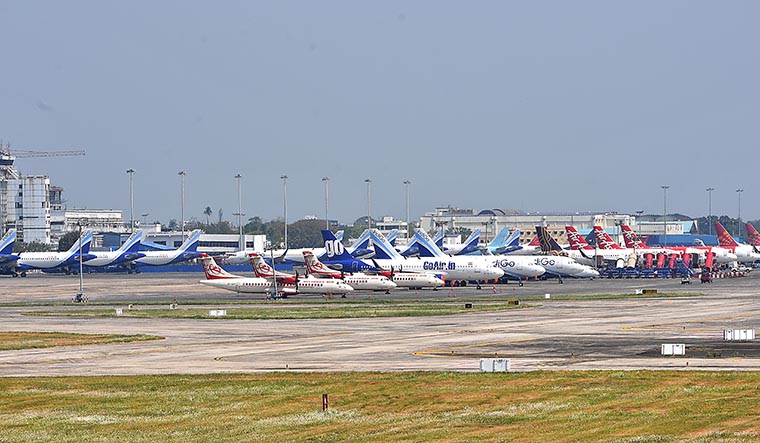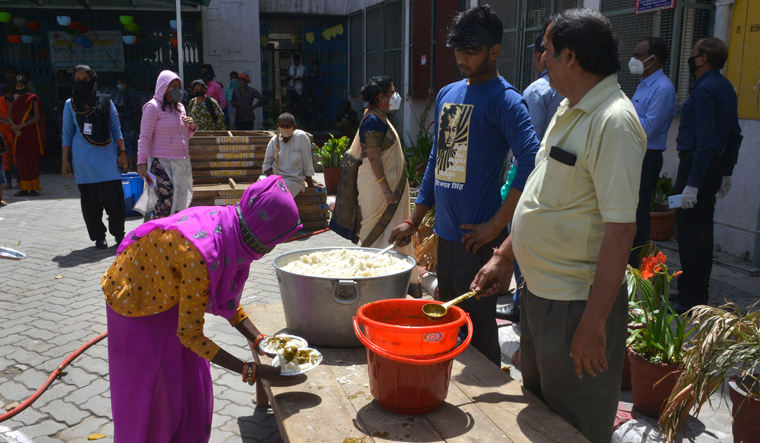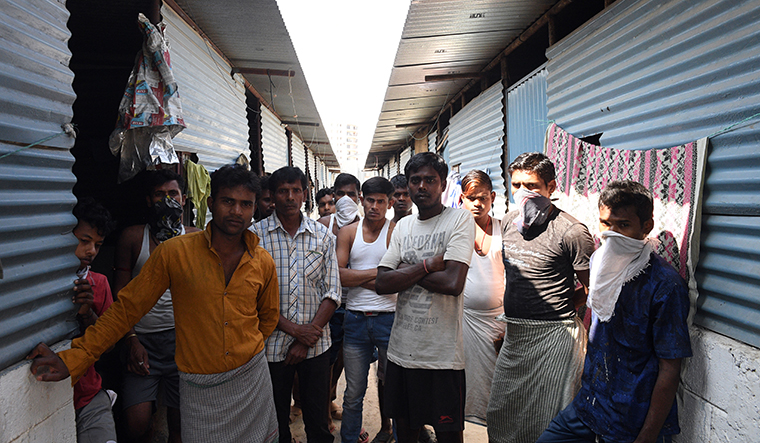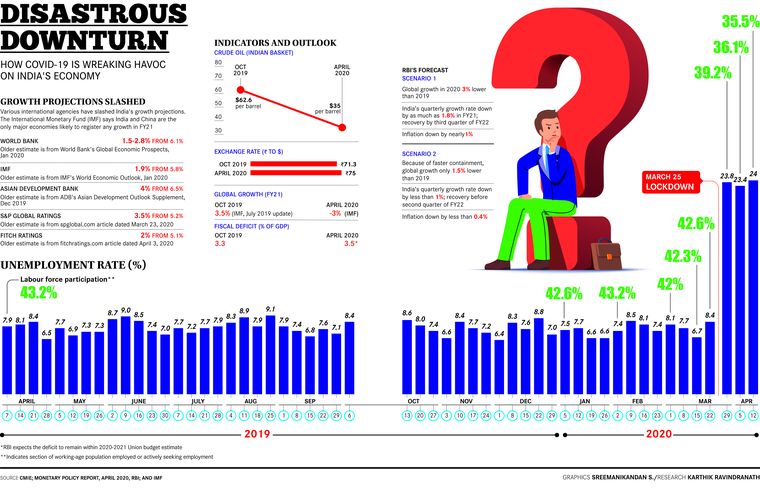Social distancing is the new world order. As of now, it is the only effective intervention against the Covid-19 pandemic. Its more stringent version, lockdown, however, comes with severe side effects like loss of jobs and decelerated economic growth. But the Narendra Modi government has made its approach clear and taken the tough path, as it extended the all-India lockdown from April 14 to May 3.
Even in its initial response, the government had rightly put lives ahead of the economy. The first phase of the lockdown slowed the spread of virus, buying time for the local authorities to ramp up medical infrastructure, set up isolation facilities and ensure supply of medical equipment. It is likely to continue in some hotspot districts even after May 3.
It comes, however, at a debilitating cost to the economy, impacting livelihoods, social security and jobs. “If it is extended to end May, the additional cost will be 9 per cent of the GDP,” said Arvind Virmani, former chief economic adviser to the government. Economists say the current crisis is far worse than the one in 2008-09. The 2008 slowdown had its origin in one country and it created ripples across the world. But Covid-19 is leaving behind destruction simultaneously across the globe. All economies are in recession, and there might not be a solution in the near term.
“Even if the situation stabilises in the next one month, we have to take care of the next six,” said Bimal Jalan, former Reserve Bank governor. “The government should give fiscal stimulus and release funds for the poor and the states. The stimulus should be used where it is needed to create jobs, and not just as administrative expenditure. Those projects which are in the pipeline or ongoing should be completed rather than starting new.” The state governments have demanded financial assistance in addition to the Central funds that are due to stay afloat.
As the harvest season is on, the government has announced some relaxations in the lockdown, which primarily will help the rural economy, by allowing some economic activities to restart after April 20. These will allow MGNREGA work to restart, goods trucks to resume service, e-commerce sites and courier companies to go full steam, and IT companies to work with 50 per cent staff. Plumbers, electricians and carpenters will be allowed to work, and so would sections in construction work and manufacturing. All these activities will require sanction and passes from local administration.
“The relaxation has come at the right time as the situation was very grim to keep construction workers at the site afloat,” said Niranjan Hiranandani, president of National Real Estate Development Council. “With this order, the economic drivers of the country will start moving again, even as we extend the lockdown.”
Modi had asked all his ministers to prepare a 10-point business plan to put the economy on track. The government will come out with a detailed plan after discussions with the NITI Aayog and the Prime Minister’s Office. The next bailout package is likely to be for the micro, small and medium enterprises (MSME) sector, which forms a quarter of the economy, and may have a special fund to provide bank loans for working capital needs of the sector and tax relaxation to small units. The government is also looking at doubling its spending on infrastructure projects in an attempt to create more jobs.
The loss
“The situation is pretty bad,” said Mahesh Vyas, managing director and chief executive officer of the Centre for Monitoring Indian Economy. “It will get worse in terms of unemployment. A large number of daily wagers, agricultural labourers, and self-employed entrepreneurs are facing severe job problems.”
The first victims of the lockdown are the workers in the unorganised sector and migrant labourers. Surya Pratap, a migrant labourer from Uttar Pradesh, was forced to leave Delhi after the cooker factory he worked in shut shop. “I called my employer for salary; he told me he could not pay as he had no money. The local grocery shop stopped giving provisions on credit. I am going to Shahjahanpur,” he said, on the way to his hometown along with his wife and two children. He had brought the family to Delhi for Holi. He does not have a ration card or a bank account.
It is the same story for lakhs of migrant labourers who had walked back to their native places. They had left their villages for economic security in big cities, but are now returning for emotional security. “The workforce will return to the cities, but it will take time because of the uncertainty around virus transmission,” said Prof Chinmay Tumbe of IIM Ahmedabad. “There are likely to be massive labour shortages from mid-April onwards in major cities. I suspect most will return only later in the year since June-July is anyway spent at home even during normal times.” Since the start of the lockdown, some 12.5 lakh people, a majority of them migrant labourers, have been housed in around 21,000 relief camps across the country.
The Modi government responded to the initial distress with three key interventions—Rs15,000 crore for the health care sector, Rs1.7 lakh crore for the poor, and the Rs3.7 lakh crore liquidity infused into the market by the RBI. In the first three weeks, the government distributed about Rs29,000 crore to about 32 crore poor people.
Ironically, the industry is yet to come out with a figure for the losses it suffered. “The economic cost is huge,” said Rathin Roy, former member of the Prime Minister’s Economic Advisory Council and director of the National Institute of Public Finance and Policy. “But I am not seeing any assessment, from either the government or the private sector, of what has been the cost to them. If they are paying wages, if they are laying people off, then what is the loss? If they are paying interest on the working capital which is not being used, then what is the loss? Only when you get quantification of losses that you can give money. I am very disappointed that the private sector is not doing its job in this respect.”
Finance Minister Nirmala Sitharaman, head of the financial task force, has held several meetings with experts, MPs and industrialists to garner inputs for a stimulus package. The package may offer tax concessions, more government spending and bailout for key sectors.
The pain
All sectors are affected by the lockdown, and they are all worried about the uncertainty that the pandemic has brought with it. Even if the government eases the lockdown, sectors like hospitality, aviation and entertainment will continue to reel under the virus-induced fear and forced lifestyle changes. Restaurants, cinemas, airlines and railways will have to devise plans keeping in mind the norms of social distancing.
Social distancing can severely dent consumption and lead to a vicious cycle—uncertainty coupled with less availability means there is a drop in consumption, which makes companies look at cutting costs by less investment and job or salary cuts, which will lead to even further drop in consumption. “Recovery will be gradual. We are staring at a cascading effect down the line,” said Ajay Bakaya, managing director of Sarovar Hotels & Resorts.
The hospitality sector, along with travel and tourism, has borne the brunt of the first wave of the pandemic, and the lifting of the lockdown is unlikely to give any immediate relief. With international travel set to be virtually non-existent in the foreseeable future, the hotel industry is pinning its hopes on the domestic traveller to help the business get back to normal. Even for that, the best case scenario, according to Bakaya, is 50 per cent functional by the end of June, “with business hopefully getting normal by October.” That, of course, would depend on the lifelines from the government, like moratorium on EMIs and deferment of taxes.
Aviation associations have claimed that the global air transport industry could lose $113 billion in revenues from the passenger business in 2020. Centre for Asia Pacific Aviation, an aviation consultancy, has claimed that the Covid-19 pandemic will push most airlines in the world to bankruptcy by the end of May. According to an estimate, private domestic carriers in India are expected to post consolidated losses of up to $600 million (04,500 crore) in just one quarter, while the losses of the national carrier Air India could go up to 03,700 crore in the same period. Airlines were the first to pass on the losses to its employees. SpiceJet, Vistara, GoAir and IndiGo have announced 10 to 30 per cent pay cuts for their employees. Air India has asked for $1.6 billion bailout package from the government.
While the economy may survive the impact on hospitality or aviation sectors, any downturn in its lifeline, the MSMEs, can send the economy into a tailspin. Chandrakant Salunkhe, founder and president of SME Chamber of India, presented an ominous picture. “Nearly 7.5 lakh MSMEs may shut shop over the next few months,” he said.
Most of these companies were taken by surprise when the lockdown was announced. “The lockdown was imposed at the last moment, so most of the SMEs were not able to prepare,” said Salunkhe. “Many products are perishable and have expiry dates. So, the loss will be very big, and SMEs will find it difficult to manage.”
Just like MSMEs, lakhs of retailers are also staring at a bleak near-term outlook. According to the Retailers’ Association of India, there are more than 15 lakh retail stores in the country, generating a business of around Rs4.74 lakh crore and employing more than 60 lakh people. “If the lockdown continues till June, then there could be a scenario where 30 per cent of the retail stores have shut shop for good, leading to 18 lakh people losing their jobs,” said Kumar Rajagopalan, CEO of Retailers’ Association of India.
Apparels, jewellery, shoes, consumer electronics, durables and mobile phones are among the most affected segments in retail and they are struggling to pay rentals and wages. “Rent accounts 10-15 per cent of the costs while 8-10 per cent is salary,” said Govind Shrikhande, former managing director of Shoppers Stop. “When there is no sale at all, how do you bear these expenses?”
According to Mahendra Kajiwala, former chairman of South Gujarat Chamber of Commerce and Industries, the daily loss in the textile industry in Surat is estimated at Rs100 crore to Rs150 crore. The diamond industry in Surat, which has an annual turnover of around Rs1,48,000 crore and employs seven lakh workers, had been badly hit even before Covid-19 cases started emerging in India, said Dinesh Navadia, chairman of Gujarat unit of Gem Jewellery Export Promotion Council.
The automobile industry, which was losing Rs2,300 crore a day even before the lockdown, has fallen into deeper troubles, as lockdown has washed away a few weeks. “Right now the patient is in the ICU; so the whole effort will be to get him out of there,” said Rajeev Chaba, president and managing director of MG Motors India. “(In) April and May it all depends on when the government lifts the lockdown and how many days of production we get. After three months, the whole question will be on the consumer demand. How many would want to buy a car? The regeneration of demand will be a slow process.”
While the lack of consumer demand is a threat looming in the distance for the real estate and construction sector, the immediate concern is the availability of labour and raw materials. “It is a challenging situation,” said Hiranandani. “The pandemic may have migrant labourers running to the perceived safety of their villages, but earning money is something which will have them returning to the cities, to the construction sites.”
Hiranandani believes there will be increased demand in residential real estate. “Families living in rented homes will appreciate the advantage of living in one’s own home during emergencies like the Covid-19 pandemic,” he said.
The pharma and health care sectors stand to gain from the export demand for essential medicines and medical equipment. For long, Indian drug makers have been importing active pharma ingredients (APIs) from China because they are cheaper than the locally made APIs. That seems to be changing. “India has become a preferred supplier of APIs and API intermediates for global markets. In the long run this will have a great positive impact on overall Indian economy,” said Kushal Suri, head of international business development at the pharmaceutical company Morepen Laboratories.
The IT sector, however, does not see any light at the end of the tunnel. Its main revenue generating markets, the US and Europe, have been severely hit by Covid-19, and it is likely to have a long-term impact. According to a recent report by the research firm International Data Corporation (IDC), there would be a decline of 3-4 per cent in global IT spending. “Given the complex business scenario today, most of the IT companies have to keep pace with maintaining client deliveries with most staff working from home. The new business development will see a much slower growth rate for the next two quarters,” said Deepak Mittal, CEO of To The New, a digital technology company.
As the government gets busy with identifying sectors that need a bailout, one sector which may be overlooked is the startups. As several projects have gone on a hold mode, startups are struggling to deal with the sudden drop in revenue. “Post the lockdown most of the startups will be affected, irrespective of the sectors they come from, as their revenue streams have been hit,” said Jyoti Bowen Nath, managing partner at Claricent Partners. “The focus is to sustain the business with minimal costs and prepare to bounce back when the economy opens up.”
The remedy
During the 2008 financial crisis, prime minister Manmohan Singh advised the G20 nations on a Keynesian financial stimulus. Many experts now are pushing for the same intervention to put more money in people’s hand and boost demand.
Most economists agree on three immediate solutions for the current crisis—ramp up health infrastructure to deal with the disease; provide food and transfer cash to workers and migrants; give a bailout package for the stressed industry. “We have to do what it takes to protect two things, one is the migrant labour, and second the unorganised sector,” said Roy. “An interesting thing is that both migrant labour and unorganised labour are part of the third problem, which is to maintain supply chain, because supply chains are not maintained by Swiggy. Supply chains are maintained by migrant labourers who load and unload goods and move trucks. You have to take care of your unorganised sector, and that will take care of your supply chain.”
He is surprised that no window has been opened for the state governments. “Release of disaster funds is very little,” he said. “I have been arguing that the government has to put up to Rs2 lakh crore at the disposal of the state governments.”
Many economists have asked for putting in place a universal basic income programme to help people in distress. Another suggestion is to make public distribution system geographically neutral. Many migrant workers rushed home during the lockdown because they have ration cards at their native places. “Currently, the One Nation One Ration Card scheme is slated to be released in June. Ideally, this should be implemented at the earliest,” said Tumbe.
Industry is asking for a bigger package of 2 to 3 per cent of the GDP (about 06 lakh crore), which would be comparable to what other countries have announced. “India may be losing close to Rs40,000 crore daily because of the national lockdown, with an estimated total loss amounting to Rs7 to 8 lakh crore during the first 21 days of the lockdown. Close to 40 million jobs are at risk during the April-September 2020 period. Hence an urgent relief package is critical,” said Sangita Reddy, president of FICCI and joint managing director of Apollo Hospitals.
Various industry bodies have submitted a list of suggestions to the government, ranging from deferment of taxes and subsidised loans for MSMEs to immediate release of payments owed by the government and PSUs to vendors. “Special support is also needed for severely affected sectors such as tourism and hospitality,” said Chandrajit Banerjee, secretary general, Confederation of Indian Industry.
As epidemiologists race to find a vaccine for Covid-19, the world may never be the same again. What the lockdown has done is to press a reset button, where businesses, social interactions and lifestyles have been forced to change. The lasting effects of this change remain to be seen.
With K. Sunil Thomas, Nachiket Kelkar, Pradip R. Sagar, Abhinav Singh and Nandini Oza







